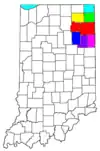Fort Wayne metropolitan area, Indiana
As of March 2020, the Fort Wayne–Huntington–Auburn Combined Statistical Area (CSA), or Fort Wayne Metropolitan Area, or Northeast Indiana is a federally designated metropolitan area consisting of eight counties in northeast Indiana (Adams, Allen, DeKalb, Huntington, Noble, Steuben, Wells, and Whitley counties), anchored by the city of Fort Wayne.[1]
Fort Wayne CSA
Northeast Indiana | |||
|---|---|---|---|
| Fort Wayne–Huntington–Auburn, IN CSA | |||
 | |||
Fort Wayne–Huntington–Auburn, IN CSA
| |||
| Coordinates: 41°N 85°W | |||
| Country | United States | ||
| State(s) | Indiana | ||
| Largest city | Fort Wayne | ||
| Other cities | - Huntington - New Haven - Auburn - Bluffton - Kendallville | ||
| Area | |||
| • Total | 3,199.62 sq mi (8,287.0 km2) | ||
| Population (2020) | |||
| • Total | 645,409 | ||
| • Rank | 79th in the U.S. | ||
| Time zone | UTC−05:00 (EST) | ||
| • Summer (DST) | UTC−04:00 (EDT) | ||
| ZIP Codes | ZIP codes
| ||
| Area code(s) | 260, 574, 765 | ||
The CSA is further divided into one metropolitan area (Fort Wayne) and six Micropolitan Areas (Angola, Auburn, Bluffton, Decatur, Huntington, Kendallville). As of the 2020 census, the CSA had a population of 645,409.[2][3] The Fort Wayne metropolitan area is part of the Northern Indiana region, containing about 2.2 million people, and is considered part of the Great Lakes Megalopolis, which contains an estimated 59 million people.
Combined Statistical Area
Metropolitan Statistical Area (MSA)
- Fort Wayne (Allen and Whitley counties)
Micropolitan Statistical Areas (μSAs)
Communities
Places with more than 100,000 inhabitants
- Fort Wayne (Principal city)
Places with 10,000 to 100,000 inhabitants
Places with 1,000 to 10,000 inhabitants
Places with fewer than 1,000 inhabitants
Townships
Adams County
Allen County
- Aboite Township
- Adams Township
- Cedar Creek Township
- Eel River Township
- Jackson Township
- Jefferson Township
- Lafayette Township
- Lake Township
- Madison Township
- Marion Township
- Maumee Township
- Milan Township
- Monroe Township
- Perry Township
- Pleasant Township
- St. Joseph Township
- Scipio Township
- Springfield Township
- Washington Township
- Wayne Township
Wells County
Notable residents
- Chris Schenkel, former Sportscaster for ABC Sports. Born in Bippus.[4]
See also
References
- "OMB Bulletin No. 20-01, Revised Delineations of Metropolitan Statistical Areas, Micropolitan Statistical Areas, and Combined Statistical Areas, and Guidance on Uses of Delineations of These Areas" (PDF). Office of Management and Budget. March 6, 2020. Retrieved August 12, 2021.
- "U.S. Census website". United States Census Bureau. Retrieved February 23, 2022.
- "Metropolitan and Micropolitan Statistical Areas". U.S. Census Bureau. July 1, 2011. Archived from the original on October 20, 2013. Retrieved October 19, 2013.
- "Chris Schenkel". Yesteryear.clunette.com. Retrieved March 21, 2022.

